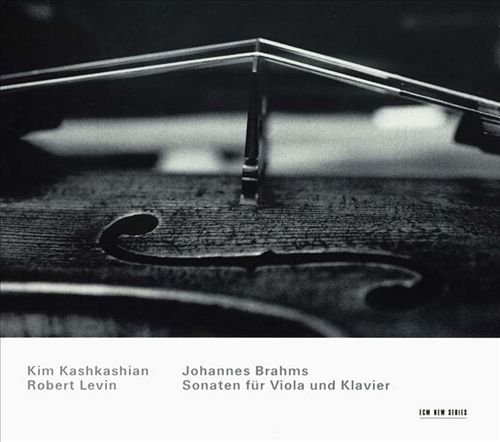Kim Kashkashian, Robert Levin - Johannes Brahms - Sonaten für Viola und Klavier (1997)

Artist: Kim Kashkashian, Robert Levin
Title: Johannes Brahms - Sonaten für Viola und Klavier
Year Of Release: 1997
Label: ECM
Genre: Classical
Quality: FLAC (image+.cue,log,scans)
Total Time: 44:04
Total Size: 219 Mb
WebSite: Album Preview
Tracklist: Title: Johannes Brahms - Sonaten für Viola und Klavier
Year Of Release: 1997
Label: ECM
Genre: Classical
Quality: FLAC (image+.cue,log,scans)
Total Time: 44:04
Total Size: 219 Mb
WebSite: Album Preview
Johannes Brahms (1833-1897)
Sonate Nr. 2 in Es-Dur
1. Allegro amabile 8:29
2. Allegro appassionato - Sostenuto - Tempo I 5:30
3. Andante con moto - Allegro - Più tranquillo 7:21
Sonate Nr. 1 in f-Moll
4. Allegro appassionato - Sostenuto ed espressivo 8:04
5. Andante un poco Adagio 5:05
6. Allegretto grazioso 4:24
7. Vivace 5:09
Performers:
Kim Kashkashian, Viola
Robert Levin, Klavier
These two sonatas, originally written for clarinet, marked the end of an intense period of depression for Brahms, during which his creative energies had all but faded. Kim Kashkashian, whose command of the viola unearths an even deeper realm of possibility in this already engaging diptych, faithfully captures the somber circumstances of its creation. In doing so, she shows that the viola is no less an instrument of breath, drawing from deep within her lungs the sheer vocal power required to carry across such arresting music.
The disc opens with the Sonata No. 2, evoking the spirit of its underlying “tragic motive” as if it were the weight of an all-consuming desire. The entire sonata, but especially the first movement, flows with what I can only call an urgent delicacy. The looser third movement makes for a more abstract statement, never seeming to settle until it is dashed off with a declamatory flourish in its concluding Allegro. As arousing as the second sonata is, the Sonata No. 1 is perhaps the more fully fleshed of the pair. The second movement is for me the most effective portion of the album. It unfurls the viola’s heart like no other recordings (excepting Kashkashian’s, of course) can. Its yearning melody moves like grass bending in the wind, expressing in its pliancy a total acceptance of emotional upheaval and the growth that upheaval fosters. Just as the Andante casts its lyrical spell, so does the final Vivace enchant with gorgeous pockets of emptiness, drawing in thick lines the journey of its own resolution.
As one would expect of Brahms, the piano writing is superb at every turn, providing Robert Levin the perfect foil by which to extol the wonders of this richly blessed composer. Once again, he and Kashkashian prove themselves to be a finely matched pair. They maintain respectable dynamic distance throughout, balancing the latter’s robust vibrato with the former’s assertive yet nuanced touch. In spite of the darkness that binds these sonatas, their rewards are nothing if not radiant.
The disc opens with the Sonata No. 2, evoking the spirit of its underlying “tragic motive” as if it were the weight of an all-consuming desire. The entire sonata, but especially the first movement, flows with what I can only call an urgent delicacy. The looser third movement makes for a more abstract statement, never seeming to settle until it is dashed off with a declamatory flourish in its concluding Allegro. As arousing as the second sonata is, the Sonata No. 1 is perhaps the more fully fleshed of the pair. The second movement is for me the most effective portion of the album. It unfurls the viola’s heart like no other recordings (excepting Kashkashian’s, of course) can. Its yearning melody moves like grass bending in the wind, expressing in its pliancy a total acceptance of emotional upheaval and the growth that upheaval fosters. Just as the Andante casts its lyrical spell, so does the final Vivace enchant with gorgeous pockets of emptiness, drawing in thick lines the journey of its own resolution.
As one would expect of Brahms, the piano writing is superb at every turn, providing Robert Levin the perfect foil by which to extol the wonders of this richly blessed composer. Once again, he and Kashkashian prove themselves to be a finely matched pair. They maintain respectable dynamic distance throughout, balancing the latter’s robust vibrato with the former’s assertive yet nuanced touch. In spite of the darkness that binds these sonatas, their rewards are nothing if not radiant.
![Ben Aylon, Roei Hermon - SMALL ROOM IN DAKAR (2025) [Hi-Res] Ben Aylon, Roei Hermon - SMALL ROOM IN DAKAR (2025) [Hi-Res]](https://www.dibpic.com/uploads/posts/2025-12/1765640683_pl8lfacmwajwc_600.jpg)


![Norbert Schneider - Guitar Speaks (2025) [Hi-Res] Norbert Schneider - Guitar Speaks (2025) [Hi-Res]](https://www.dibpic.com/uploads/posts/2025-12/1765494310_j09zk3wvbwioc_600.jpg)




![Frank Sinatra - Christmas (Remastered) (2013) [Hi-Res] Frank Sinatra - Christmas (Remastered) (2013) [Hi-Res]](https://www.dibpic.com/uploads/posts/2025-12/1765618088_fsc500.jpg)